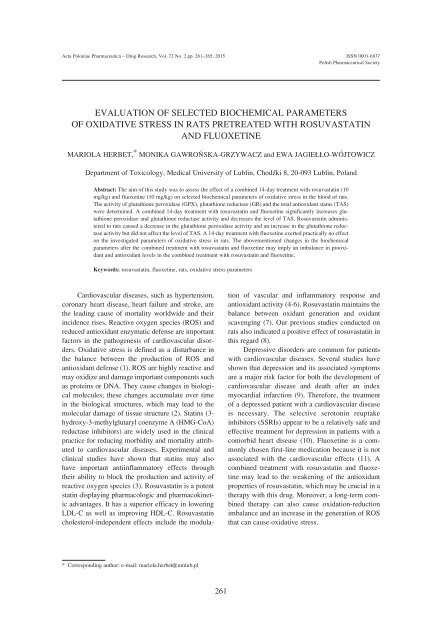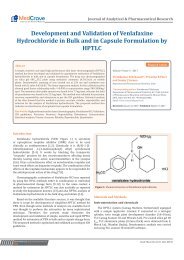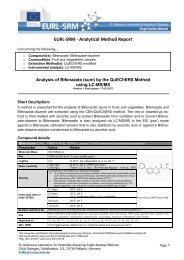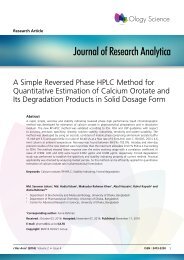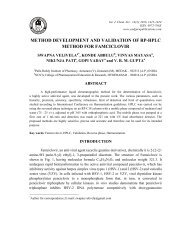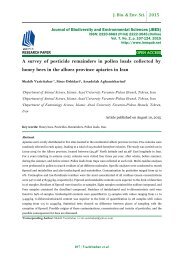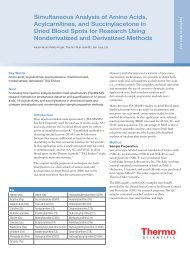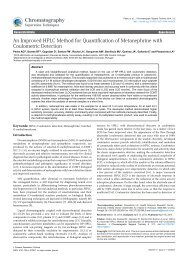acta 2_2015
acta 2_2015
acta 2_2015
- No tags were found...
Create successful ePaper yourself
Turn your PDF publications into a flip-book with our unique Google optimized e-Paper software.
Acta Poloniae Pharmaceutica ñ Drug Research, Vol. 72 No. 2 pp. 261ñ265, <strong>2015</strong> ISSN 0001-6837Polish Pharmaceutical SocietyEVALUATION OF SELECTED BIOCHEMICAL PARAMETERSOF OXIDATIVE STRESS IN RATS PRETREATED WITH ROSUVASTATINAND FLUOXETINEMARIOLA HERBET, * MONIKA GAWRO—SKA-GRZYWACZ and EWA JAGIE££O-W”JTOWICZDepartment of Toxicology, Medical University of Lublin, Chodüki 8, 20-093 Lublin, PolandAbstract: The aim of this study was to assess the effect of a combined 14-day treatment with rosuvastatin (10mg/kg) and fluoxetine (10 mg/kg) on selected biochemical parameters of oxidative stress in the blood of rats.The activity of glutathione peroxidase (GPX), glutathione reductase (GR) and the total antioxidant status (TAS)were determined. A combined 14-day treatment with rosuvastatin and fluoxetine significantly increases glutathioneperoxidase and glutathione reductase activity and decreases the level of TAS. Rosuvastatin administeredto rats caused a decrease in the glutathione peroxidase activity and an increase in the glutathione reductaseactivity but did not affect the level of TAS. A 14-day treatment with fluoxetine exerted practically no effecton the investigated parameters of oxidative stress in rats. The abovementioned changes in the biochemicalparameters after the combined treatment with rosuvastatin and fluoxetine may imply an imbalance in prooxidantand antioxidant levels in the combined treatment with rosuvastatin and fluoxetine.Keywords: rosuvastatin, fluoxetine, rats, oxidative stress parametersCardiovascular diseases, such as hypertension,coronary heart disease, heart failure and stroke, arethe leading cause of mortality worldwide and theirincidence rises. Reactive oxygen species (ROS) andreduced antioxidant enzymatic defense are importantfactors in the pathogenesis of cardiovascular disorders.Oxidative stress is defined as a disturbance inthe balance between the production of ROS andantioxidant defense (1). ROS are highly reactive andmay oxidize and damage important components suchas proteins or DNA. They cause changes in biologicalmolecules; these changes accumulate over timein the biological structures, which may lead to themolecular damage of tissue structure (2). Statins (3-hydroxy-3-methylglutaryl coenzyme A (HMG-CoA)reductase inhibitors) are widely used in the clinicalpractice for reducing morbidity and mortality attributedto cardiovascular diseases. Experimental andclinical studies have shown that statins may alsohave important antiinflammatory effects throughtheir ability to block the production and activity ofreactive oxygen species (3). Rosuvastatin is a potentstatin displaying pharmacologic and pharmacokineticadvantages. It has a superior efficacy in loweringLDL-C as well as improving HDL-C. Rosuvastatincholesterol-independent effects include the modulationof vascular and inflammatory response andantioxidant activity (4-6). Rosuvastatin maintains thebalance between oxidant generation and oxidantscavenging (7). Our previous studies conducted onrats also indicated a positive effect of rosuvastatin inthis regard (8).Depressive disorders are common for patientswith cardiovascular diseases. Several studies haveshown that depression and its associated symptomsare a major risk factor for both the development ofcardiovascular disease and death after an indexmyocardial infarction (9). Therefore, the treatmentof a depressed patient with a cardiovascular diseaseis necessary. The selective serotonin reuptakeinhibitors (SSRIs) appear to be a relatively safe andeffective treatment for depression in patients with acomorbid heart disease (10). Fluoxetine is a commonlychosen first-line medication because it is notassociated with the cardiovascular effects (11). Acombined treatment with rosuvastatin and fluoxetinemay lead to the weakening of the antioxidantproperties of rosuvastatin, which may be crucial in atherapy with this drug. Moreover, a long-term combinedtherapy can also cause oxidation-reductionimbalance and an increase in the generation of ROSthat can cause oxidative stress.* Corresponding author: e-mail: mariola.herbet@umlub.pl261


